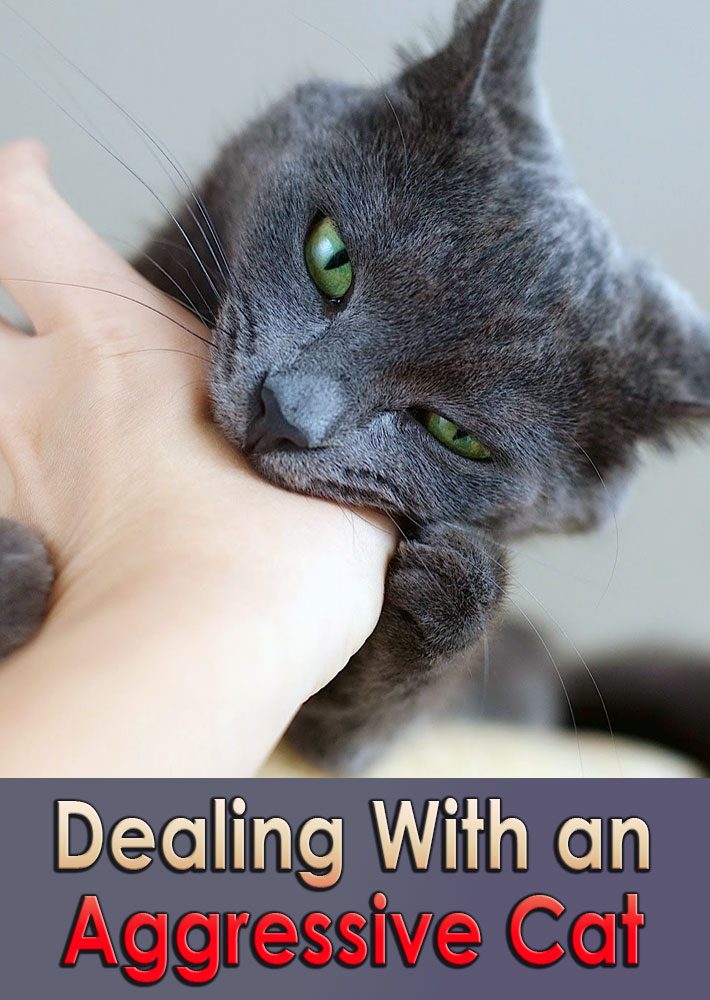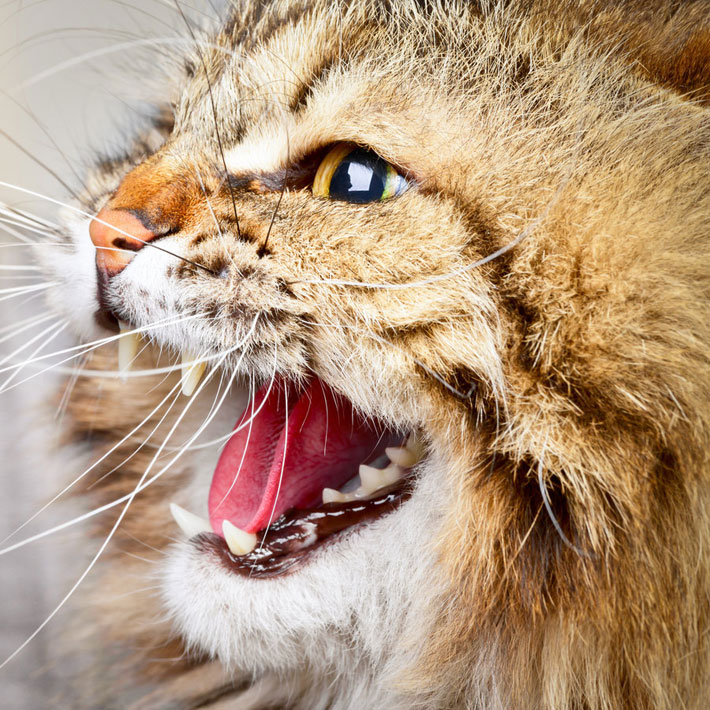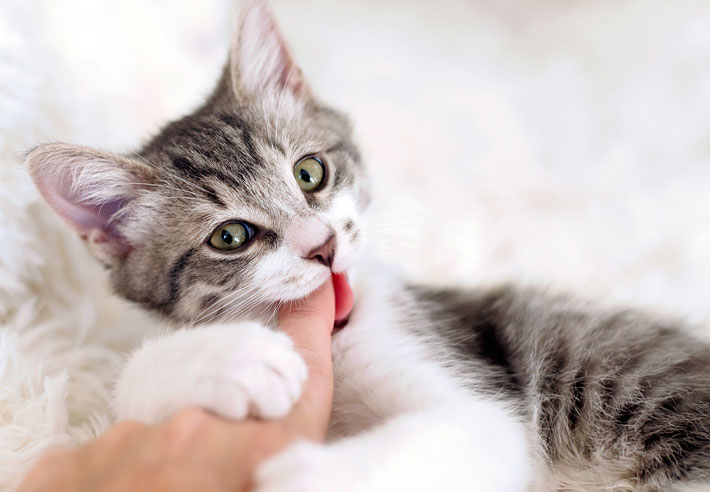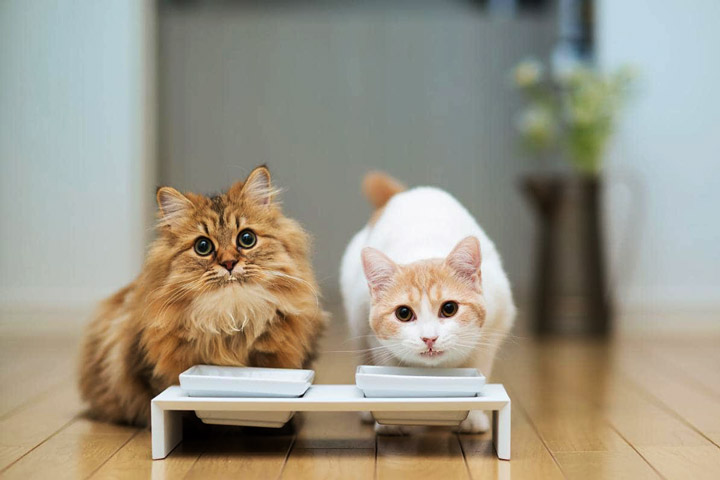
Cats don’t get aggressive out of nowhere. An aggressive cat is usually behaving that way for a good reason. Here are seven reasons why cats become aggressive — plus the warning signs and how to handle each.
Even the most experienced cat caretakers can find themselves charged up on adrenaline when having to face a cat in the midst of a fit of aggression. But encountering a hissing, growling, screaming, and possibly even scratching and biting cat can strike terror into the hearts of people who don’t know how to handle an aggressive cat. But cats don’t just suddenly go crazy: There are almost always warning signs and there’s almost always a good reason for cat aggression. Here are seven reasons why cats become aggressive and how to handle an aggressive cat.
1. Cats Become Aggressive Because They’re in Pain
Cats who are in pain will respond with hisses and swats when sensitive areas are touched. My cat, Siouxsie, does this if I accidentally put pressure on her sore hips. A hard yank on the tail, for example, can be quite painful. Ignore the warning signs and a scratch and possibly even a bite may follow. This is especially true if the pain is a result of physical abuse such as being kicked or hit.
2. Fear Can Cause Cat Aggression
A terrified cat will respond with body language that’s obvious to an experienced cat caretaker: She will turn sideways and puff up her tail and fur in order to look larger. Her ears will flatten backwards, she will hiss and her pupils will dilate. Attempting to approach a cat in this state is risking an aggressive reaction, not because the cat dislikes you but because she’s in the middle of a panic reaction.
3. Hormones May Cause a Cat to Become Aggressive
A cat who is not spayed or neutered is much more likely to be aggressive. Male cats in particular are biologically wired to fight with other male cats when females in heat are present. If you see two cats fighting, do not physically intervene because you will almost certainly become the target of the cats’ aggression.

4. Cats Can Get Aggressive Due to Frustration
“Redirected aggression” is the term for violent acts carried out by cats because they can’t reach the object of their predatory passion. For example, an indoor cat who sees another cat walking by or marking his territory in “his” turf may get into a highly reactive state. At that point, anyone unfortunate enough to be nearby, whether that’s another cat, a dog or a person, may end up on the receiving end of the cat’s aggression.
5. Cat Aggression Happens Due to Stress
If a cat lives in a highly stressful environment — for example, a home in which people are fighting or a home with too many cats — it’s quite possible for that cat to be quick to respond aggressively. Like children who live in homes with a lot of verbal and physical violence, or a lot of unspoken anger, cats often act out the dynamics of their human families.
6. An Aggressive Cat Might Be Responding to Trauma
Don’t laugh: Cats can suffer from post-traumatic stress. Their brains are wired similarly to ours, and the effects of chronic anxiety from past human violence or struggling to survive on the streets can lead cats to become aggressive. In order to resolve this issue, a short course of anti-anxiety medication (prescribed by a vet, of course; don’t give your cat your antidepressants, please), homeopathic remedies or flower essences can help make a cat less reactive to triggers.
7. Chemical Imbalances Can Cause Cat Aggression
This is by far the rarest reason for cats to become aggressive. But like humans, some cats simply have biochemical imbalances that affect behavior. For these cats, antidepressants or anti-anxiety medications can be a lifesaver.
Handling an Aggressive Cat: Dos and Don’ts
Do
- Provide a variety of toys for your cat so you can determine his preferences. In general, cats seem to enjoy batting at small toys, like balls and fake mice. They also like to stalk, chase and pounce on things that move like prey, such as toys with feathers attached to flexible rods that you can dangle and move about. Frequently give your cat new objects to investigate, such as paper bags or cardboard boxes.
- Twice a day, spend at least ten minutes playing with your cat. During playtime, don’t encourage him to bat at your hands or feet. Instead, direct the play away from you by using a long dangly toy or throwing your cat’s favorite toys. Schedule play sessions to coincide with times when your cat seems most active and playful.
- If your cat likes to grab your feet as you go up and down the stairs or hide under things and ambush your ankles or legs as you walk by, carry toys with you and toss them ahead of you to redirect his attention. Try to get him to focus on chasing the toys instead of attacking you.
- Consider adopting another cat as a playmate. If you do, choose a young, playful cat like your current cat.
- Build an outdoor enclosure for your cat, complete with branches, boxes, shelves and perches for him to navigate. If you can provide a more complex environment for your cat, full of opportunities to hunt insects and chase leaves, your cat will be less motivated to play with you.
- Consistently give your cat “time-outs” when he plays too roughly. The instant he starts to bite or scratch you, end the game by leaving the room. Don’t attempt to pick up your cat and put him in another room for the time-out as this could provoke more bites.

NOT to Do
- Do not encourage your cat to play with your hands, feet or any other body part. While it may be fun when you have a tiny kitten, it becomes painful and dangerous as your kitten grows up.
- Do not use toys that teach your cat to play with your hands, such as gloves with balls hanging from the fingers. If you do, your cat will be encouraged to direct his play at your hands and won’t understand that it’s only okay to attack your hands when you’re wearing the toy gloves.
- Do not physically punish your cat for rough play. If you hit or slap your cat, he may perceive your actions as play and become even rougher. Alternatively, he might become fearful of your hands and respond by avoiding you or changing from play to real aggression.
- Never run from your cat or try to block his movements with your feet. These actions can cause your cat to intensify his play or become aggressive.
Additional Tips
If your cat insists on directing his play at you, despite your best efforts to encourage him to play with toys, you can interrupt his rough play behavior by squirting him with water from a spray bottle. A short blast of compressed air (no sound) from a can might also be an effective deterrent. You’ll need to carry your water bottle or air canister with you at all times when your cat is likely to ambush you so that you can deliver the spray the instant he starts to run at you. If your aggressive cat pounces on you and you don’t have your water bottle or air canister handy, try clapping your hands loudly to startle him. As soon as he stops, throw a toy away from you to direct his play behavior toward the toy. Small wads of paper kept in your pocket or in likely ambush places around the house often work well as substitute toys.
The bottom line on handling an aggressive cat
No matter what the cause of the aggression, there are almost always warning signs. If you understand feline body language, you’ll be able to see that your furry friend is getting wound up before the situation escalates to a crisis point. If you have a highly reactive cat and you want to help him or her, be aware that it will take time and patience — but take it from a person who has rehabilitated traumatized cats: The reward is so worth the effort!




Leave a Reply